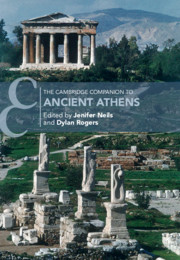Book contents
- The Cambridge Companion to Ancient Athens
- Cambridge Companions to the Ancient World
- The Cambridge Companion to Ancient Athens
- Copyright page
- Contents
- Contributors
- Abbreviations
- Athens: An Introduction
- 1 #Leagros: An Athenian Life
- Part I The Urban Fabric
- Part II Inhabitants
- Part III Business/Commerce
- Part IV Culture and Sport
- Part V Politics
- Reception
- Index
- References
Part IV - Culture and Sport
Published online by Cambridge University Press: 10 March 2021
- The Cambridge Companion to Ancient Athens
- Cambridge Companions to the Ancient World
- The Cambridge Companion to Ancient Athens
- Copyright page
- Contents
- Contributors
- Abbreviations
- Athens: An Introduction
- 1 #Leagros: An Athenian Life
- Part I The Urban Fabric
- Part II Inhabitants
- Part III Business/Commerce
- Part IV Culture and Sport
- Part V Politics
- Reception
- Index
- References
Summary

- Type
- Chapter
- Information
- The Cambridge Companion to Ancient Athens , pp. 293 - 376Publisher: Cambridge University PressPrint publication year: 2021
References
Further Reading
Rihll 2003 discusses the general dynamics of teaching and learning in ancient Athens, while Natali 2003 and Haake 2010 offer short overviews of the philosophical schools’ topography and practices. On their various doctrines, see Long and Sedley 1987; on sculpted representations of philosophers, see Zanker 1995; on images of education on Athenian vases, see Oakley 2020, 103–112. For particulars regarding Plato’s Academy, consult Caruso 2013 and Kalligas et al. 2020; for Aristotle and the Lyceum, Natali 2013. Clay 2009 examines Epicurus’ Garden, and Kechagia 2010 the Stoa.
Bibliography
Further Reading
This chapter summarizes Pritchard 2013. The other monograph on Athenian athletics is the still indispensable Kyle 1987. On Greek athletics in general, see Phillips and Pritchard 2003, Miller 2004, and Christesen and Kyle 2014. For images of sport on Athenian vases, see Oakley 2020, 131–166. On Athenian competitive festivals, see Osborne 1993. For the most thorough treatment of the Great Panathenaia, see Shear 2021.
Bibliography
Additional resources to accompany this chapter can be found at: www.cambridge.org/NeilsRogers
Further Reading
The literature on this topic is rich and mainly in German and modern Greek. The problem of the ‘old agora’ and the topography of earlier Athens is analyzed in Miller 1995 (especially 218–219). Of the vast bibliography about the origins of drama, see Csapo and Slater 1994, 79–138, 286–301; Green 1994, especially 16–48; Connor 1996; Sourvinou-Inwood 2003, 141–172; Csapo and Miller 2007, 1–38; Kowalzig and Wilson 2013. Wiles 2000 is a good introduction to the art of Greek theater performance. On the Theater of Dionysos, in addition to the classic Pickard-Cambridge 1946, a recent presentation of the wooden theater can be found in Moretti 1999–2000 and in Papastamati-von Moock 2015, while for the Lycurgan phase, Papastamati-von Moock 2014 is very useful. On the Odeion of Perikles, see Robkin 1976; Miller 1997, 218–242; Shear 2016, 197–228 (for a discussion within the wider framework of Perikles’ building activity). For a discussion of the theatrical spaces of Athens and Attika in the Roman period, see Di Napoli 2013, 7–25.
Bibliography
Additional resources to accompany this chapter can be found at: www.cambridge.org/NeilsRogers
Further Reading
The literature on these subjects is vast; a good place to start is Parker 2005. Attic processions are the subject of chapters in Friese 2019. Mylonas 1961 is still the locus classicus for the site of Eleusis, now supplemented by the extensive work of Clinton, in particular Clinton 1992 and 2005/2008. On the nature and modern study of Mystery religions, see Cosmopoulos 2003 and Bremmer 2014. For the argument that the ritual dates back to the Bronze Age, see Cosmopoulos 2015. The City Eleusinion is thoroughly published by Miles 1998. For a general overview of the Panathenaia, see Neils 1992 and 1996, and Neils and Tracy 2003; more comprehensive is Shear 2021. For discussion of the Telesterion and the Odeion of Perikles, see Shear 2016.
Bibliography
Additional resources to accompany this chapter can be found at: www.cambridge.org/NeilsRogers
Further Reading
To set ancient Athenian eating and drinking in a wider Mediterranean context, see Wilkins and Nadeau 2015. Dietler and Hayden 2001 provide theoretical background on communal feasting from a broad anthropological perspective. The seminal work on the ancient Greek symposion remains Murray 1990. Van den Eijnde et al. 2018 presents many facets of the history and impact of communal dining on the development of the polis in general. Glazebrook and Tsakirgis 2016 offers several case studies covering eating and drinking at Athenian taverns and brothels. The perceived relationship between ancient Greek diet and health is covered in Jouanna 2012, while Papathanasiou et al. 2015 provides an analysis of the physical evidence for nutrition in ancient Greece. Wilkins 2000 analyzes thoroughly the central role of food and eating as revealed in publicly performed comedies. Finally, Davidson 1998 explores how eating and drinking in combination with sexual behaviors are defining aspects of Athenian culture.
Bibliography
Additional resources to accompany this chapter can be found at: www.cambridge.org/NeilsRogers
Further Reading
The bibliography on ancient Greek sexual behavior is vast. Halperin et al. 1990 provides the standard constructionist view. Robson 2013 gives a readable and insightful overview, along with Ormand 2018, which also considers Roman sexual practices. The collections of Masterson, Rabinowitz, and Robson 2015 and Hubbard 2013 include excellent essays on a wide range of topics. The best recent work on the archaeological remains for Athenian sex work is the collection of Glazebrook and Tsakirgis 2016 (with references to earlier work). For perceptive essays on vases and sculpture, see the collection of Cohen 2000. Kilmer 1993 is the standard work on Attic red-figure erotica.
Bibliography
Additional resources to accompany this chapter can be found at: www.cambridge.org/NeilsRogers

